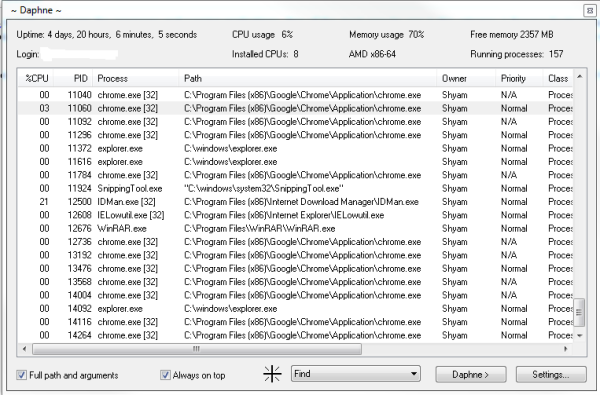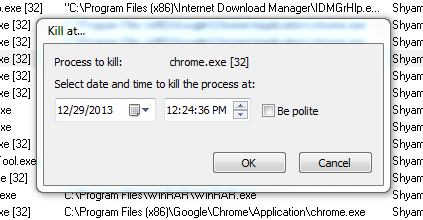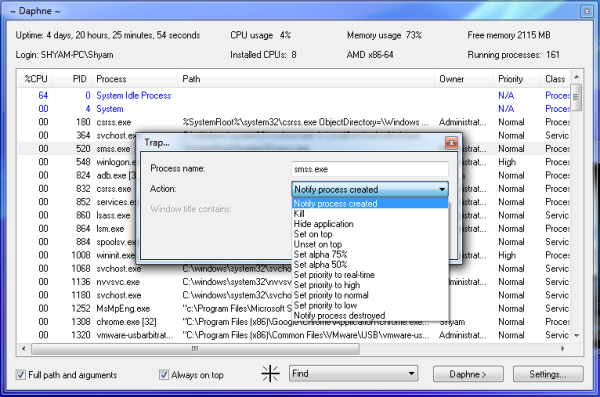Over the years, we have seen many Task Manager replacements to help us manage the processes and running applications. One of the most popular in this category is Process Explorer by Sysinternals, which takes the whole system debugging and process management to another level. Then many replacements came after that, which almost mimicked the Process Explorer-like System Explorer, What’s Running, Process Hacker, etc. Today I found this free Task Manager alternative software called Daphne task Manager.
Daphne Task Manager replacement
Daphne is a Process management tool that offers lots of features. But the main feature that Daphne boasts about is the ability to kill the process. Apart from that, we can also manage a process efficiently and help debug a specific application. Let’s look at some of the useful features that Daphne offers.
Kill a Process in Windows
To kill a process, you have an option to Kill, Kill Politely, Kill At, Kill Politely At. The feature I like the most is the ability to schedule to kill an application which I think is very useful and comes in very handy for a power user. Just right-click on the process you want to Kill at a scheduled time and set a date & time.
Then you can use the cross symbol (+) and select “Kill” from the drop-down next to it and virtually drag and drop it to the application you want to kill, which is a cool feature. There are a couple of other options like Find the application in the process list (same as in Process Explorer), Hide application, Set on top, Unset on top, Set different alpha levels, Enable and Disable. Most of the functions are those we might use while troubleshooting or debugging an application. You also have an option to Trap an application based on the user’s input!
When you click on the Daphne button, you have a couple of options like Run Process, Run Process As, Close Window by name, etc. Now, if you want to see the Process list in a Tree to see which process is running under which application you click, click on Process Tree, which will open up in a Tree view to help you identify the underlying process.
You also have an option the view the installed application. It shows the information about the application. Also, you can uninstall it from there. You can also see the Raw information of the installed application. Something like this:
AuthorizedCDFPrefix:
Comments:
Contact:
DisplayVersion: 4.5.50709
HelpLink:
HelpTelephone:
InstallDate: 20131127
InstallLocation:
InstallSource: C:\dd80e69208f1e760ba691984a61d\
ModifyPath: MsiExec.exe /X{1AD147D0-BE0E-3D6C-AC11-64F6DC4163F1}
NoModify: 00000001h
NoRepair: 00000001h
Publisher: Microsoft Corporation
Readme: http://go.microsoft.com/fwlink/?LinkId=249107
Size: 00009B34h
EstimatedSize: 00135DA3h
SystemComponent: 00000001h
UninstallString: MsiExec.exe /X{1AD147D0-BE0E-3D6C-AC11-64F6DC4163F1}
URLInfoAbout: http://go.microsoft.com/fwlink/?LinkId=249109
URLUpdateInfo: http://go.microsoft.com/fwlink/?LinkId=249110
VersionMajor: 00000004h
VersionMinor: 00000005h
WindowsInstaller: 00000001h
Version: 0405C615h
Language: 00000000h
DisplayName: Microsoft .NET Framework 4.5
Here is a glance at all the features of Daphne:
- Enhanced (experimental) multi-desktop feature: use up to four windows desktops using WindowsKey + F5 to F8.
- Installed software list for inspecting installed software available in the tray icon menu. Installed software
- Check the process hierarchy tree using the “Show process tree” at the tray icon menu. Process tree
- Parent process name and PID at process’ properties.
- Now you can make the configuration portable using the INI file instead of the registry base configuration.
- Support for DRK’s process database information search and contribution.
- Hide application tool: drop the target over the application’s window you want to hide. Later, you can restore the application from the Daphne menu.
- Take care: process names may be eclipsed by malicious software.
- Find process window tool: identify the process which owns the targeted window.
- Traps: you can set up traps to be applied to any process being created.
- Detailed process list, including full path and arguments.
- Per process detail including Windows tree, thread list, modules, environment variables.
- Using the windows tree, you can: Show, hide, always set on the top on or off, set focus, et cetera to any given window.
- Kill all by name: Kill all processes using a given name.
- Kill menu: Customizable menu. Each menu item has a process list to kill upon activation.
- Process list highlighting with colors for custom, system, and high CPU-consumption processes.
- Control inspector window for revealing hidden passwords.
- Drag and drop tool for killing, setting alpha, enabling controls, and putting windows always on the top.
- “Hide Java VM from the command line” option in the Advanced tab makes Daphne strip the path to the default Java VM in full path mode.
- Internationalization: Spanish, Italian, German, French, Chinese, Valencian, Polish, Russian, Portuguese, Japanese, Arabic, and Greek support.
To conclude, Daphne is a great little application with many features. If you’re an IT Pro or a power-user, this application will make your life a lot easier – though there is a lot of room for improvement, like the ability to search a process in other websites like Virus Total instead of just drk.com.
If you’re looking for a replacement for the Windows Task Manager, you should look at Daphne Task Manager. You can download it from here.
Is using a third-party Task Manager safe?
Usually yes. Most of these Task Manager apps use Windows API to do the same thing which the Windows Task Manage achieves. However, they can get more data and share more information using logic and data, making them better than the default one on Windows. However, you will not be able to delete the default task manager in Windows.



Leave a Reply